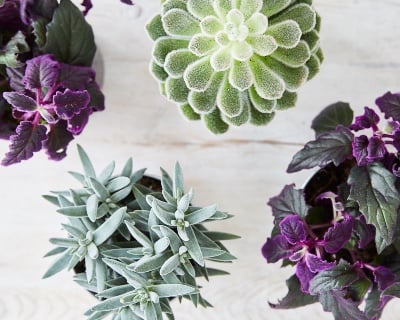Houseplant design principles: texture
Texture adds another dimension to your houseplant displays through the visual qualities of the plants' leaves
While it can be a subtle design feature compared to the more obvious effects of colour and scale, texture offers a vital sensory element in houseplant displays. A plant's surface type determines how it interacts with light and shadow, which gives each species a unique presence. For example, velvety foliage has a soft, matte appearance while smooth, glossy leaves present a crisper, more clean-cut image.
The greater the contrast, the greater the emphasis on each plant's individual presence. A succulent such as the plump, fleshy donkey's tail (Sedum morganianum) will accentuate the spiky prickles of a bunny ear cactus (Opuntia microdasys), for example. In the wreath, fleshy, plump
When similar-textured plants are grouped together, the quality of light and shadow across their foliage is consistent, creating a relationship between the plants despite any other visual differences such as colour and size. This relationship unifies the display, creating a balanced whole and imparting a sense of simplicity.
A grouping of plants that interact with light in the same way (absorbing or reflecting it, offering similar textural patterns of light and dark) will give a sense of unity that brings the composition together as a whole. Beware though, that too much repetition creates monotony. A thoughtful combination of similar textures, offset by some contrasting elements, creates lots of visual interest.
This article is adapted from the RHS Practical Houseplant Book.




